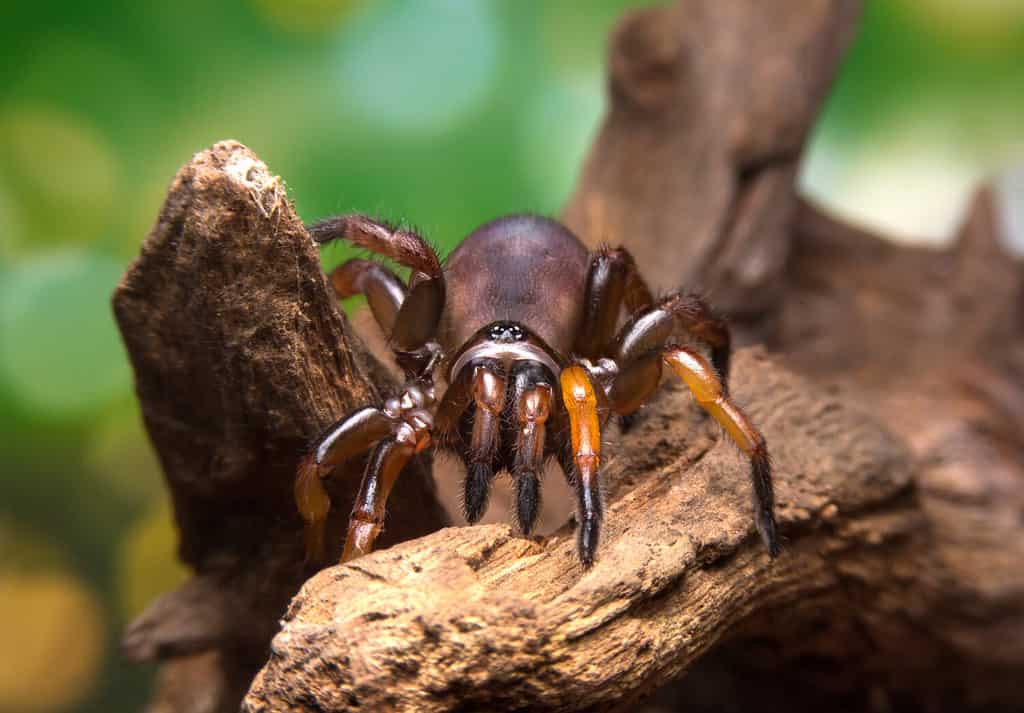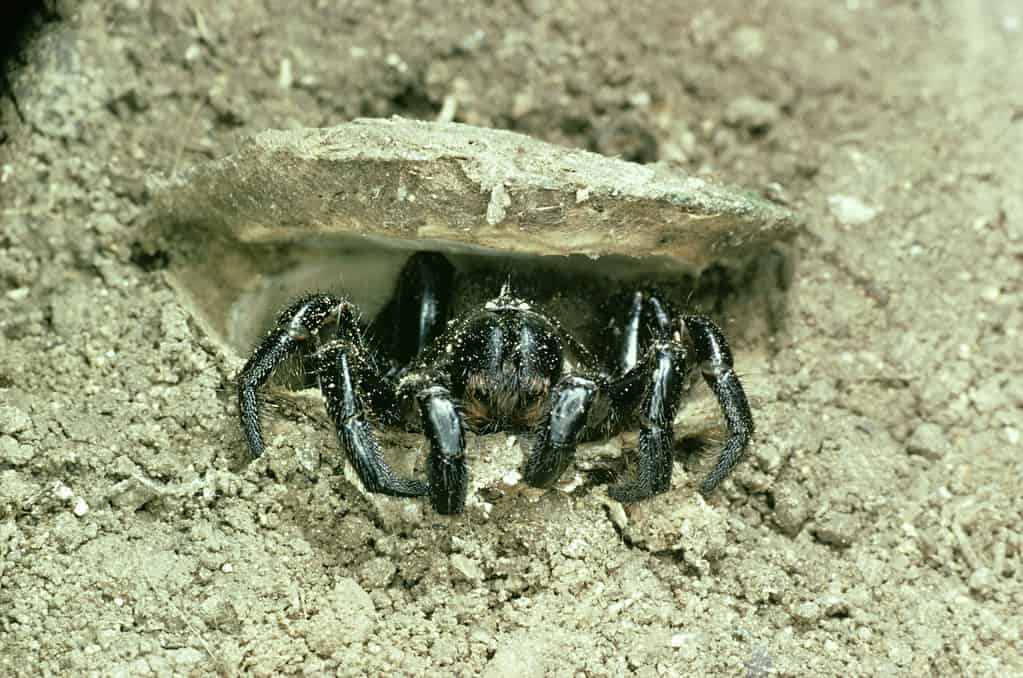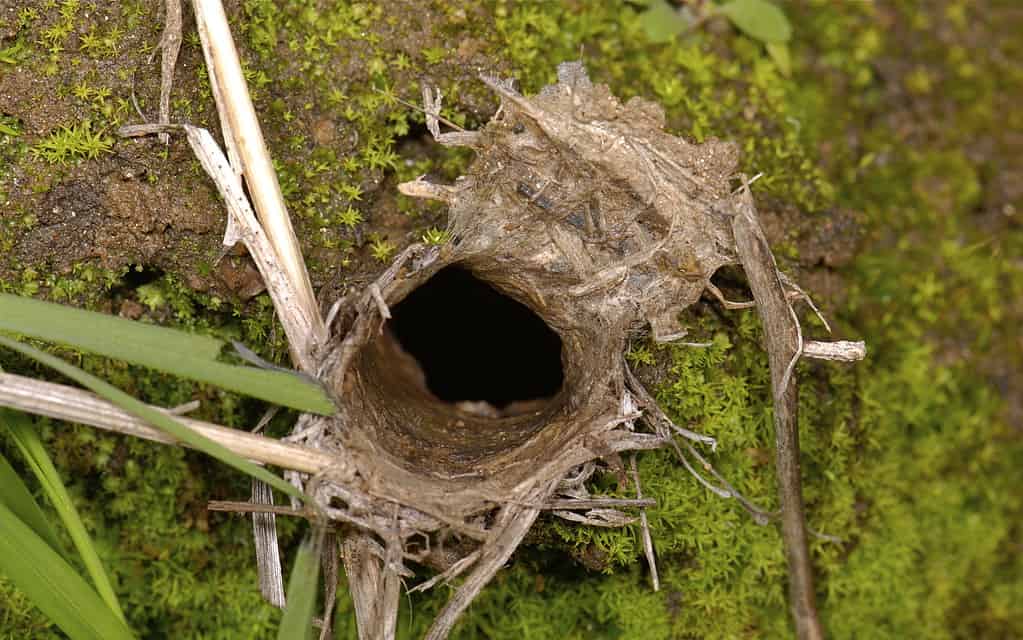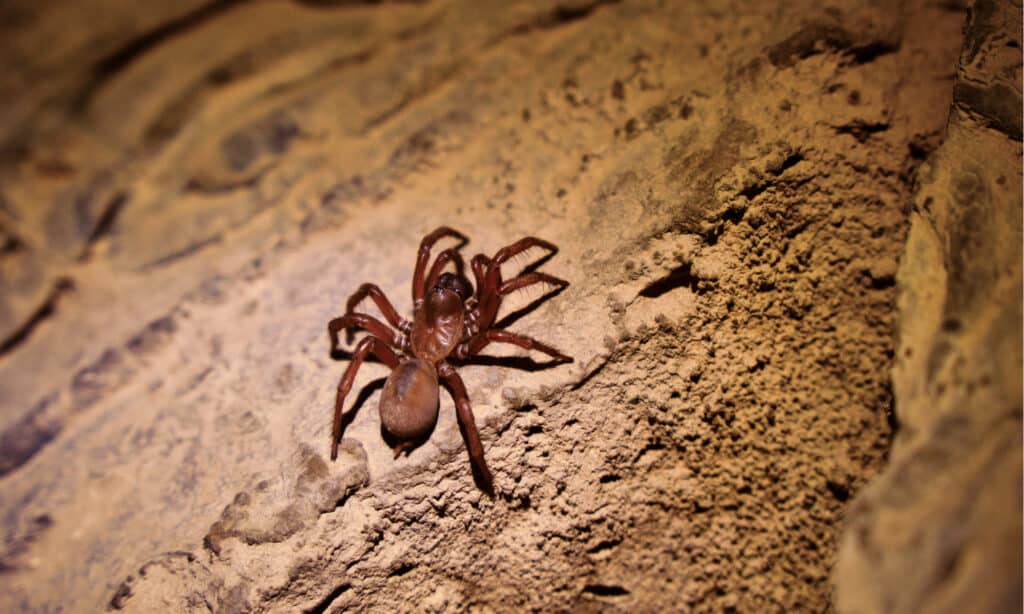Trapdoor spiders are not the scariest spiders out there, though they are in the Australian tarantula and funnel web spider family. They aren’t even the biggest spiders, but how big do trapdoor spiders get? They have been seen in the news lately as being discovered in fossil form in the great continent of Australia, but how big is that enormous fossil? It was five times the average size of the modern-day trapdoor spider. Sounds enormous, right?
In a previous article, we discussed where the Australian trapdoor spider lives and what it eats, so be sure to follow up with that and our other trapdoor spider article. Let’s discuss the amazing trapdoor spiders, how to identify them, and other interesting facts that set this ancient spider apart. We promise this is one unique arachnid!
Meet the Trapdoor Spider

The oldest trapdoor spider on record was 43 years old!
©Pichit Sansupa/Shutterstock.com
Trapdoor spiders are just flat-out cool. They are very reclusive, and the females never leave their den or burrow once they have matured. The oldest known wild trapdoor spider, closely monitored by researchers, didn’t move out of her mother’s burrow until she was 12. To say they are homebodies is a bit of an understatement, but can you blame them? The world can be terrifying to a small, easily killed spider. There are plenty of other times of tunnel-digging animals, but they are all someone’s prey in one way or another. Being a ferocious hunter with a fantastic ability to stay hidden their entire lives doesn’t give them invisibility.
Trapdoor spiders belong to the infraorder Mygalomorphae, also known as primitive spiders. Primitive spiders sometimes have segmented bodies and legs. They also have downward-facing chelicerae. The spiders must pierce their prey in a stabbing fashion, unlike other spiders who have clasping chelicerae to grab onto prey and hold it. There are many types of trapdoor spiders, at least several hundred. Some of the spiders have flap-like doors, while others do not have a trapdoor at all. Many people consider true trapdoor spiders to only fall under the family Ctenizidae.
Ctenizidae

The Ctenizidae family consists of the true trapdoor spiders.
©© Oxford Scientific/Photodisc via Getty Images
Trapdoor spiders in the Ctenizidae family may sometimes be called corkscrew trapdoor spiders due to the shape and type of trapdoor they create. The family is made of medium-sized mygalomorph spiders. They tend to all have stout-looking armored red or black bodies with short, thick legs. They sometimes appear shiny and have large fangs, like their cousins, the tarantula. Their chelicerae come equipped with rake-like spines called rastellum, used to dig their burrows.
The females are always larger than the males and can be difficult to identify. These are fairly small spiders and are not harmful. The spiders can be slightly more than half an inch to slightly more than an inch in size. The trapdoor spider will try to run away or hide instead of biting. Their bite is painful but is not dangerous unless you are allergic.
The Breeding Life of a True Player Means Survival of Their Species
The males are smaller and have much shorter lifespans. They spend time in a burrow until they reach maturity, and then they pack up and head out to look for love, kind of. It takes years for trapdoor spiders to reach maturity. The male trapdoor spider may rear up if threatened, though the females rarely do so and stay hidden for their lives.
Once the males have headed out independently, they will look for females by tasting webbing near trapdoors that they find. If the spider is female, they will wait until she emerges to see what she’s caught and carefully advance on her. Males come equipped with a spur on their front legs, which helps keep them alive to find another female after the first has been mated. After he has mated with several females, he will perish.
Where Do Trapdoor Spiders Live?

The burrow of a trapdoor spider comes complete with a door made from webbing, sticks, and leaf litter.
Trapdoor spiders can be found worldwide, though most are in tropical areas. Few of these unique spiders inhabit the US, though they can be found in the southern and western portions of the country. Specifically, they are from Virginia down to Florida, from Florida on the east coast, and from Florida to Colorado throughout the deep south and west coast.
The trapdoor spiders are frequently seen along disturbed banks and forest ravines of dirt and rock. However, the clever little spiders prefer loose or sandy soil since it is easier to dig a burrow in. They are even sometimes located in the desert.
How the Burrow is Constructed

©Geartooth Productions/Shutterstock.com
When creating a burrow for the first time, the small juvenile spider digs its hole using their rastellum like a shovel. It isn’t quite as simple as digging a pit is for humans. The spider makes balls of dirt using its mouth and rastellum. They coat the balls of dirt in mucus and, using their back legs, kick it out of the burrow.
The trapdoor spider also coats the inside of the burrow in mucus, mud, and webbing to stabilize the walls. It then closes off the entrance to the tunnel in thick webbing, which it uses its teeth to cut through and open outward, leaving a piece as a hinge.
As the juvenile grows larger with every molt, they will make their tunnel larger by kicking more saliva-covered dirt balls out the front door. The burrow tends to be about an inch in diameter.
Different Styles of Trapdoor Spider Burrows

Like the shotgun houses in New Orleans, the most well-known trapdoor spiders create long, straight tunnels or “rooms” without branching.
©temis/ iStock / Getty Images Plus via Getty Images
Most commonly, especially with the Ctenizidae or “true trapdoor spiders,” the spider will create a thick corkscrew-type door by packing a mucusy mud mixture. The spiders who create this type of trapdoor generally have one branch to their tunnel that does not exceed five inches.
Other trapdoor spiders use different techniques and style their doors a bit differently. Some even create a tunnel system with various branches. Two openings to the burrow allow them to escape danger and predators quickly. The spider often has a round trapdoor on each entrance to its burrow, reminiscent of a hobbit den in fairytales.
With the one-door system and shotgun housing look, as you will see in old New Orleans homes, trapdoor spiders are much more likely to meet their end by way of a predator. The predatory wasp is one of the biggest threats. Spiders with multiple branches and doors mostly tend to live in Australia.
Some may construct thin wafer-like doors with leaf litter and twigs as camouflage. The sticky web coating helps to make this step possible. Camouflage is critical if the spider wants to survive and catch prey. The trapdoor spider will sometimes place sticks and leaves around the outside of the door to use as an alarm system for prey near the burrow door.
Does Size Matter in the Spider World?

Trapdoor spiders are not the biggest, but they are amazing in their hunting and tunnel-building skills.
©Willem Van Zyl/iStock via Getty Images
Trapdoor spiders are impressive; there is no denying that. Now that you’ve learned a bit about them, their size may come as a surprise. These are brilliant, instinct-driven beings that are as old as dinosaurs. The first creature similar to a spider, perhaps more like a scorpion/spider hybrid, was the Attercopus fimbriungus, which lived 386 million years ago. That anarchid lived roughly 150 million years before dinosaurs!
They haven’t made it this long because they aren’t good at being alive. These small spiders are unlike any other creature on this planet and have barely evolved in billions of years. That shows that the original design was perfect, unlike anything humans create. Now, let’s discuss the small stature of these survivalists.
Overall, the trapdoor spider is in the medium range as far as the measurement goes. Some spiders can barely be seen with the naked eye, like the Patu digua, which are only .43 millimeters long. The largest spider, by leg span, is the giant huntsman spider, measuring 12 inches, and the largest by weight is the goliath bird-eating spider, coming in at 11 inches in leg span and five or six ounces in weight.
Trapdoor Spider Size
The spiders may only be .4 – 1.1 inches long, but are mighty. Recently discovered, the largest trapdoor spider fossil in Australia measures five times the average size of a current-day trapdoor spider, making it under 5 inches, including leg span. That’s still nowhere near the size of the modern-day largest spider. They may be small, but they are mighty. Between their tricky and intricate tunnel-creating, well-camouflaged trapdoors, their way of quickly grabbing their prey through the cracked trapdoor, and their large downward piercing fangs, these spiders more than make up for their small size.
So no, size does not matter for the smallish trapdoor spiders. They are fierce and clever hunters who outlive most spiders by being homebodies, eating in their homes, and outsmarting their prey and predators. The dinosaurs may be long gone, but these strange little spiders will probably outlive everyone.
Interesting Facts About Trap Door Spiders

This ultra-rare Liphistius Maewongensisas trapdoor spider was found in Thailand.
©Venus Saksongmuang/Shutterstock.com
- A trapdoor spider’s bite is very painful and has been compared to the sting of a wasp, though it is not harmful.
- The trapdoor spider’s nest is like real life and much scarier for the insect version of the jack-in-a-box, the children’s terrifying toy.
- The rarest trapdoor spider is the Euoplos dignitas, found in Brisbane, Australia. It measured two inches long, and due to its habitat being eradicated, it is now very rare.
- Trapdoor spiders do not use webs to catch their prey in the traditional sense. Instead, they are ambush predators that pounce on their prey and drag it into their burrows when the time is right.
- Unlike many other spiders, the trapdoor spider has sparse hair on its body and legs.
- The trapdoor spider plays a very important role in keeping the cricket, roach, beetles, and other spider numbers healthy.
- Trapdoor spiders look like small, mostly hairless tarantulas.
- The Chinese hourglass trapdoor spider is sometimes referred to as the Oreo cookie spider because of the likeness of its behind to that of an Oreo cookie. Once, a farmer found one of these spiders plugging its tunnel with its behind and thought he’d found an ancient Chinese coin. Some also say it’s behind and looks like the Aztec sunstone.
The photo featured at the top of this post is © Tobias Hauke/Shutterstock.com
Thank you for reading! Have some feedback for us? Contact the AZ Animals editorial team.







